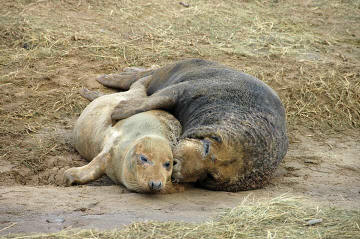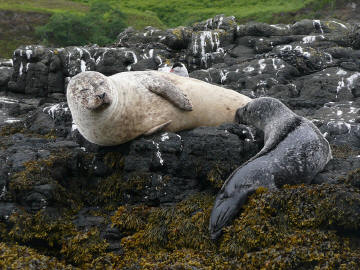Article
Grey Seal
Latin Name: Halichoerus grypus
aka
Atlantic Grey Seal and
Horsehead
Seal Half of the worlds population of
grey seals are to be found off the coast of Britain. Numbers have doubled since
1960. It is estimated that 120,000 seals are around the coasts of the UK.
It is the typical seal seen off the northern and
western coasts of Britain and Ireland.
They breed in several colonies on and around the coasts, notably large colonies
are on the Farne Islands off Northumberland (about 6,000 animals), North Rona,
the Monarch Islands and the Isle of May off the north coast of Scotland, Lambay
Island off the coast of Dublin and Ramsey Island off the coast of Pembrokeshire.
They can be seen in their breeding colonies from
September in West Wales, October in Western Scotland, as late as November in
the Farne Islands and November and December at Donna Nook in Lincolnshire. They are protected by law during their breeding season which
is from 1st September to December 31st. The best time to see them is when the
tide is out. |



 |
Identification
Males are larger than
females have broad shoulders and an elongated snout with heavy muzzle. Females
have a less rounded profile and thinner snout. Vary in colour from dark brown to
grey or black with blotches with the females generally being paler.
|
Animal
Facts
In Britain: Around the costs particularly
during the breeding season off North Scotland, Cornwall, east coast of England,
South Wales and Ireland.
Life Span: Males up to 25 years, Females 35
years.
Statistics: Males 210cm long and weight 230kg, Females are 180cm
long and weigh 155kg
Habitat: Live in water but come ashore to
breed on exposed rocky shores.
Food: Fish mainly but will feed on
crustaceans, squid and octopus. Sand eels are also an important part of their
diet in many localities. Average daily food requirements is 5kg, although they
do not feed everyday.
Breeding: Females reach sexual maturity at
3.5 years and males 4-6 years. Gestation period 11.5 months, this includes a 3
month delay in the implantation of the fertilised egg. Pups are born in autumn
(September-November) in the Eastern Atlantic, and January-February in the west.
They are born with a white coat and weigh about 15kg, they gain about 2kg a day
due to the high fat content of the mothers milk. They suckle for 3 months, the
female mates again and leaves the breeding area (known as a rookery).
|
Conservation
Status

Least Concern |
Distribution: North Atlantic Ocean and all round the British Coast. The
largest populations found on the Farne Islands, the Cornish Coast and Strangford
Lough in Northern Ireland.
Behaviour: Females arrive at breeding sites first, males compete for
space nearest the females with the oldest males generally getting the better
positions, little fighting takes place. Pups cannot swim for their first 4
weeks. Favourite haul out sites include inaccessible islands, coves and caves.
Conservation Status: Protected by the Conservation of Seals Act. The
Northeast Atlantic sub-populations is considered to be endangered.
See Also
www.pinnipeds.org/species/grey.htm

www.greyseal.net/

www.snh.org.uk/publications/on-line/naturallyscottish/seals/default.asp

Our Location Guides
Farne Islands,
Northumberland

Blakeney Point,
Norfolk

Donna Nook,
Lincolnshire

National
Seal Sanctuary, Gweek, Cornwall

Seal Sands
Yorkshire

Skomer Island,
Pembrokeshire

Skokholm,
Pembrokeshire

Ramsey Island,
Pembrokeshire

|